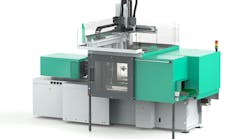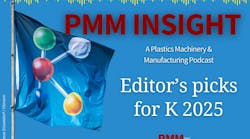Guido Frohnhaus, managing director of technology and engineering, declined to say what had been omitted from traditional Arburg presses to make the lower selling price possible. A slimmed-down version of Arburg’s control system, called Gestica Lite, was developed for the Trend line.
I think a more appropriate question is, why did it take Arburg so long to build the Trend? Engel brought out the lower-cost Wintec model 11 years ago, initially just for the Asian market, but to no one’s surprise, expanded it worldwide four years later.
Engel has reportedly sold more than 1,500 Wintec machines.
Arburg also faces growing competition from lower-cost Asian manufacturers, particularly in the North American market but in Europe as well.
The Trend looks like a good strategic move for Arburg. Processors also get another great machine choice.
To AI or not to AI?
AI was a hot topic, but machinery makers were very divided on it as a selling point for their latest hardware.
Some went all in, touting their AI systems to help processors survive labor shortages and improve part quality. Others were more nonchalant, saying their customers are not asking for AI and are not using it yet.
Most experts agree that AI will likely have a deep impact on all manufacturing and is already improving operations in some areas. Plastics processing lags behind higher-tech industries, but it will eventually be here as well.
The question is whether or not processors will pay for it now.
Chinese injection molding machinery maker Chen Hsong showed its AI Molder software package it says is designed to replace the junior operator. Since it was first unveiled at Chinaplas in April, Chen Hsong said the extra-cost option has been installed on about 300 presses.
The company said it believes AI will add significant value to molding operations and has established an intelligent manufacturing division.
To maximize the usefulness of AI-powered presses, Chen Hsong also upgraded its Smart Factory system to better link AI and factory automation and data usage.
In contrast to Chen Hsong, a Milacron executive said his company is working with AI but has not yet gone all in. Most industrial companies are still behind in AI technology, he said.
Aftermarket is no afterthought
The three-year slowdown in processing machinery sales has caused companies to run their equipment longer. That means spare parts, direct service and service contracts have become more profitable for machinery manufacturers.
Uniloy CEO Gary Riley said the aftermarket business has grown dramatically. “It has been our lifeline,” he said.
Uniloy’s blow molding machines can last 35 to 40 years with good maintenance, he said. “We have doubled our parts availability over the past three years and are maintaining a high inventory level,” Riley said.
Tobias Baur, managing director for sales and after sales at Arburg, said “After sales business presents a positive picture overall and we are at a good level. We are continuing to expand our offering in this area.”
Baur said Arburg’s aim is to ensure high machine availability and reduce operating costs. That includes service and retrofits “to keep machines up-to-date for decades.”
A good K is good for NPE?
It would have been understandable if the K 2025 attendance numbers were down from K 2022, but the final tally was 175,000 — the same as in 2022. Not bad for an industry in crisis in Europe, as several top machinery executives said.
That bodes well for NPE2027. The North American plastics industry is not in a crisis, but you could describe it as a long-running slump.
Top NPE executives were at the K show and reported strong interest in NPE2027.
So far, so good.




